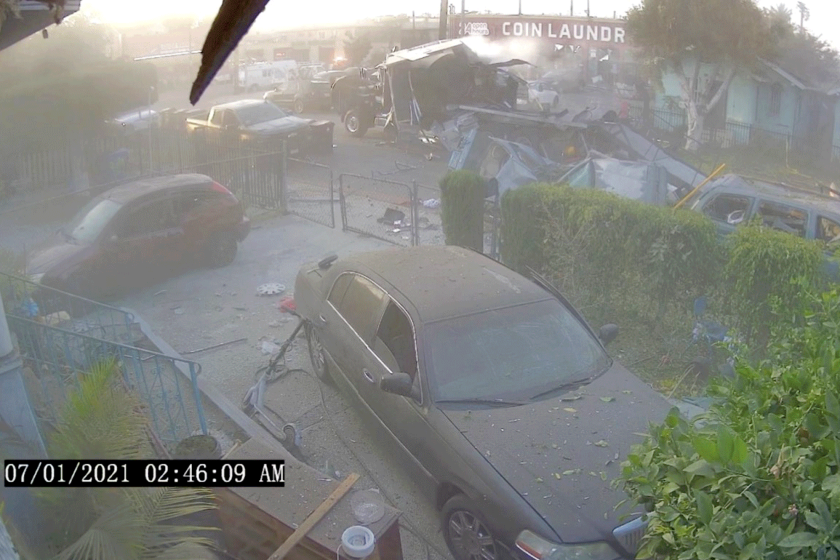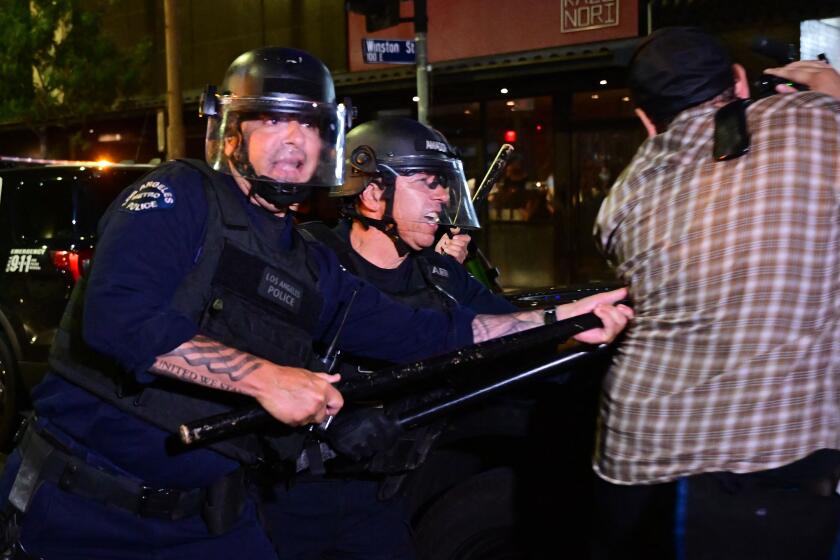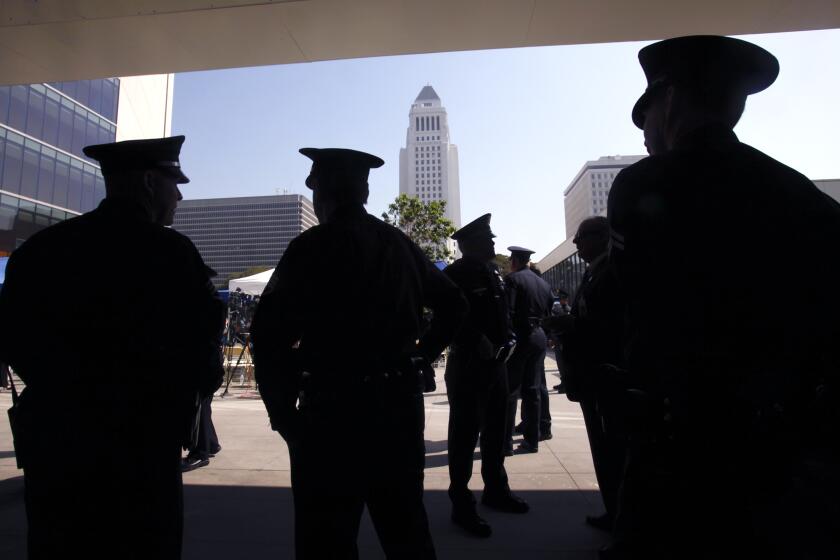News Analysis: Outrage over Times’ journalism exposes LAPD’s ignorance of a free press, experts say
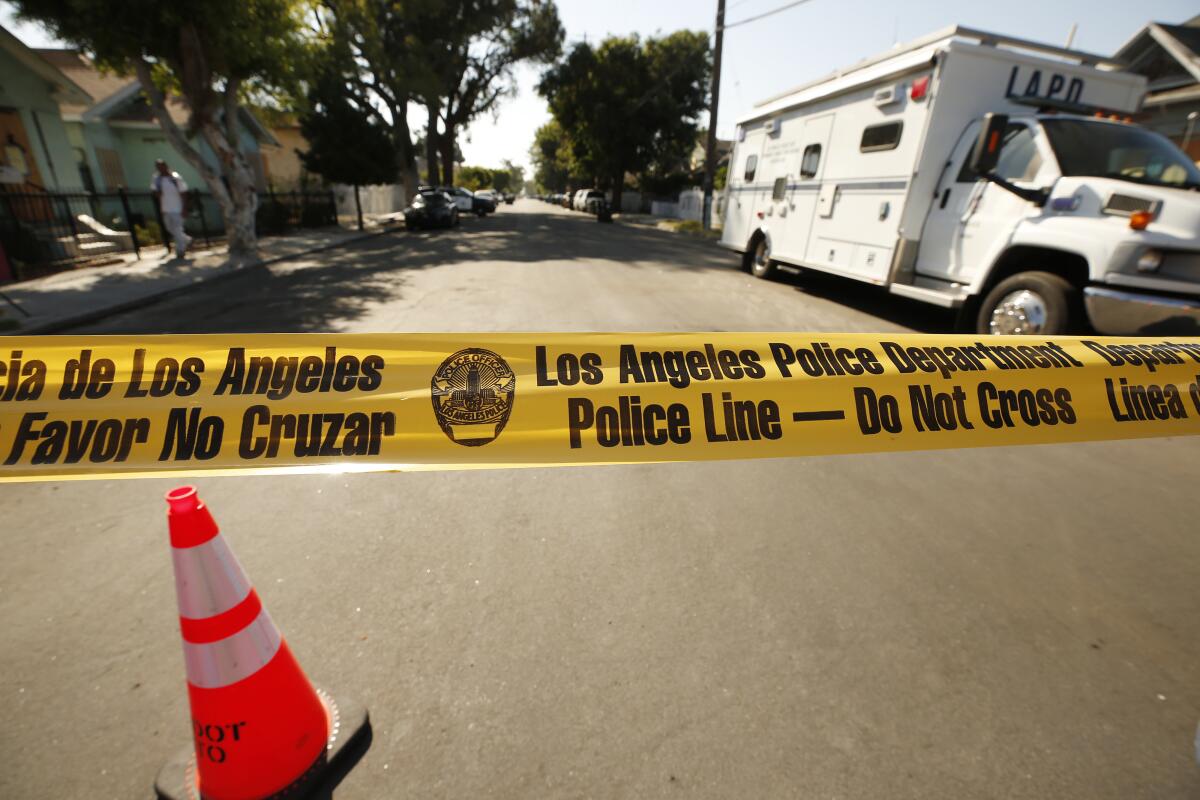
- Share via
In a routine act of journalism Saturday, two Times reporters went to the home of a Los Angeles police officer to see if she wanted to comment for a forthcoming news article. The article, they told her, would publicly name her for the first time as one of the LAPD bomb squad technicians whose botched fireworks detonation blew up a residential block in South L.A. in 2021.
Their reporting was significant because the explosion — which damaged dozens of buildings, injured 17 people and cost taxpayers millions of dollars — fueled deep anger in the community and complaints about a lack of transparency around the responsible officers.
When Sgt. Stefanie Alcocer asked the reporters to leave her property, they did.
Still, reporters Libor Jany and Brittny Mejia were accused of crossing an ethical line by LAPD Chief Michel Moore and the board of the police union. The LAPD has steadfastly withheld the technicians’ names for the last two years. Moore called the reporters and Times executive editor Kevin Merida to complain directly.
Along with input collected by The Times from local residents, a report by the LAPD’s inspector general helps paint a picture of how guesswork and a laissez-faire management style led to what it calls a “catastrophic failure.”
The reporters were also accused of “stalking” officers by the city’s police union, which sent an inaccurate account of Saturday’s interaction to its entire membership Monday.
“Random people knocking on our doors, following us, or stalking us until we get home is wrong,” the email read in part.
The incident heightened growing tensions between local L.A. media and one of the city’s most powerful public institutions. Media representatives have accused the LAPD of routinely violating their 1st Amendment rights. The city is suing a photojournalist — in part at the union’s urging — to claw back a trove of police officers’ pictures that the city itself released to him.
According to 1st Amendment scholars and media experts, the outrage over Jany and Mejia’s reporting also shows an alarming misunderstanding of the rights and responsibilities of journalists among top police officials and union bosses in one of the nation’s largest cities.
“Clearly they’ve never watched ‘All the President’s Men,’ with all those pivotal scenes where doors are being knocked on,” said Ken Paulson, former editor in chief of USA Today and now director of the Free Speech Center at Middle Tennessee State University.

The classic 1976 journalism film based on Bob Woodward and Carl Bernstein’s book portrays the Washington Post’s dogged reporting — including door knocking by the two reporters — to reveal details of the Watergate scandal that ended President Nixon’s presidency.
Paulson said objections to reporters knocking on a police officer’s door might be expected — though no more justified — from smaller, less sophisticated police departments, but the LAPD should know better. The union’s decision to blast out the reporters’ photographs in an email comparing their work to “stalking” was even more ridiculous, he said.
“The things being complained about by the union are absolute staples of American journalism,” Paulson said. “[Reporters] do have an obligation to hold public officials accountable, [and] do have a duty to ask those public officials for their side of the story.”
Joe Saltzman, a USC journalism professor who directs the Image of the Journalist in Popular Culture project at the Norman Lear Center, called the police objections “ludicrous” — and indicative of a growing misunderstanding in the U.S. of how a free press operates in a democracy.
“Getting all sides of the story is what journalists do, and anyone who tries to stop that is a knowing or unknowing threat to the freedom of information and the public’s right to know,” Saltzman said.
Bruce Shapiro, a journalism ethics professor at Columbia University, said the reporters’ efforts to get comment from the officer represented “the height of professional responsibility.”
LAPD officers used force against journalists during abortion rights protests downtown Friday night, ignoring recently expanded protections for them.
“Police officers are public servants paid by the taxpayers, and part of the responsibility of being public servants in a democracy involves answering reasonable questions from reporters about events of consequence in the community,” Shapiro said.
“This is a normal part of reporting,” he said, “and it’s disturbing for a police department or a police union to launch an intimidation campaign against reporters who are performing their essential watchdog function — which has been reaffirmed by courts since the beginning of our republic.”
Why the door knock?
In the wake of the botched detonation two years ago, residents whose lives were upended were livid and demanding answers. They wanted to know how the responsible officers, who had ignored warnings from a colleague about the explosive power of the fireworks, would be disciplined, they said.
State law generally requires the LAPD to name officers who fatally shoot people or who use force resulting in death or great bodily injury. Providing the names of officers accused of excessive force and other misconduct allows the public to assess the efficacy of the department’s disciplinary process and whether it is holding officers accountable properly.
However, when it came to the officers who were responsible for the fireworks blast — which shredded residents’ faces with window glass, damaged their eardrums and cracked the foundations of their homes — the department wouldn’t name them or detail the discipline they faced, if any.
Instead, it worked to obscure that information, at times with the help — conscious or not — of others.

Agents with the U.S. Bureau of Alcohol, Tobacco, Firearms and Explosives, who investigated the man who had stockpiled the fireworks, badly misspelled the name of the only bomb squad officer they identified in court filings — later calling it a “typo.” The LAPD’s inspector general, the department watchdog, not only left the officers’ names out of its public report on the incident, but changed the pronouns they used for Alcocer from female to male, which further obscured her identity.
Despite the obfuscation, Jany, Mejia and fellow Times reporter Richard Winton had by Saturday succeeded in identifying several of the officers, the roles they played on the day of the explosion and some of their discipline. What they didn’t have, they said, was the officers’ own accounts of what happened.
So they set out to get them.
The city of Los Angeles has sued a local journalist and an activist group after officials accidentally released photos of undercover officers through a public records request.
To ensure fairness and accuracy, reporters are trained to seek out comment from those they are writing about, particularly if they are reporting alleged misconduct.
Sometimes the subjects of stories provide additional information that clears up discrepancies or undermines the claims of others. Sometimes those accused of wrongdoing want to express personal remorse, regret or compassion, or reveal things that a police or union spokesperson would prevent them from sharing.
“Journalists know that going through a communications officer leads to a spin on the information by people in charge,” Paulson said. “You do not get a candid response from an officer if it’s filtered through someone who is paid to make the police department look good.”
Jany and Mejia had been to several officers’ homes without any problems before arriving at the home of Alcocer, a 12-year bomb squad veteran. On the day of the explosion, Alcocer had primarily been responsible for constructing a counter charge to detonate the confiscated fireworks inside a “total containment vessel” the LAPD had parked on the residential street, the reporters had learned from an inspector general’s report and interviews.
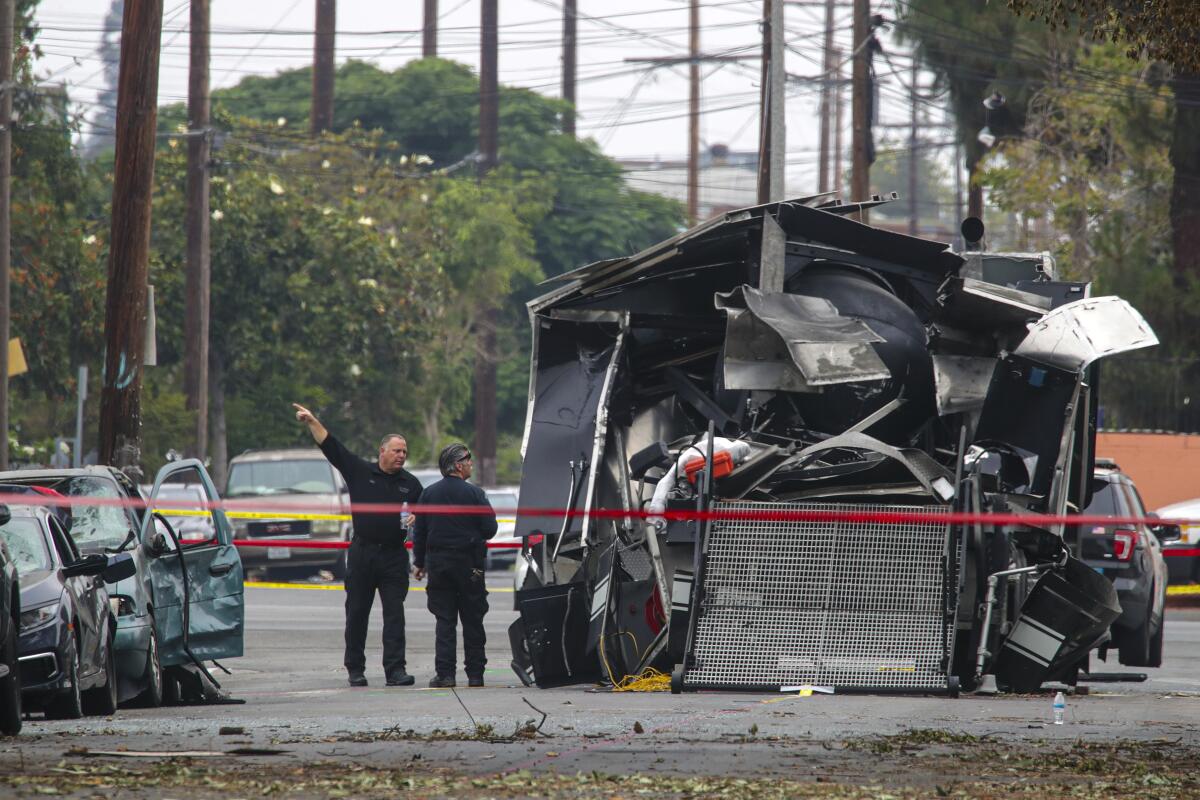
A subsequent investigation into the blast by the ATF found that the vessel failed because the technicians had badly miscalculated the explosive power of the fireworks they placed inside of it.
The reporters had learned that, after the blast, Alcocer was suspended for 10 days but later promoted to sergeant. They wanted to ask her about that.
When they knocked, a woman briefly spoke to them at the door before moving to a front window to continue the conversation from there. Jany and Mejia said they recognized the woman as Alcocer — in part thanks to a photograph of her released in the trove of pictures the department is now suing Knock LA photojournalist Ben Camacho over. But she claimed to be someone else and repeatedly referred to herself in the third person. Officials later confirmed it was, in fact, Alcocer.
The reporters said they told Alcocer they intended to name her and other bomb squad members in an upcoming story. Alcocer told them they would be putting her and the other officers in danger.
Alcocer then told them that she had to make a phone call and asked them to wait outside, they said. They stepped off her porch, and waited on the walkway to her porch for about 10 minutes. Alcocer returned and “demanded to know if we were really L.A. Times reporters,” Mejia said, so the reporters gave her their business cards.
Not long after, Alcocer came back again and asked the reporters to leave, so they did, Mejia said.
After the reporters had left, Jany realized he had a missed call from Capt. Kelly Muniz, the department’s spokeswoman, so he called her back on speakerphone from his car. Muniz rebuked him for trying to get comment from Alcocer at her home, suggesting such efforts were inappropriate, the reporters said.
Shortly after that conversation, Jany received a call from LAPD Chief Moore, who made similar claims. Moore also called and complained to Merida.
The city of Los Angeles has sued a local journalist and an activist group after officials accidentally released photos of undercover officers through a public records request.
In a later interview by text, Moore said he does not “agree with the tactic” of reporters knocking on the doors of police officers.
“Such unannounced visits unnecessarily create fear and intimidation on the part of our people and their family (including children) during a time in which we have individuals calling for violence against police officers,” Moore said.
Moore said he spoke directly with Alcocer on Saturday evening, and she “was shaken and in fear for her safety and that of her family,” in part because she didn’t know who the reporters were or what their “intentions” were.
Moore said Alcocer told him that the Times reporters “told her that she either provide a statement or they were going to publish her name and photograph this week in their story.”
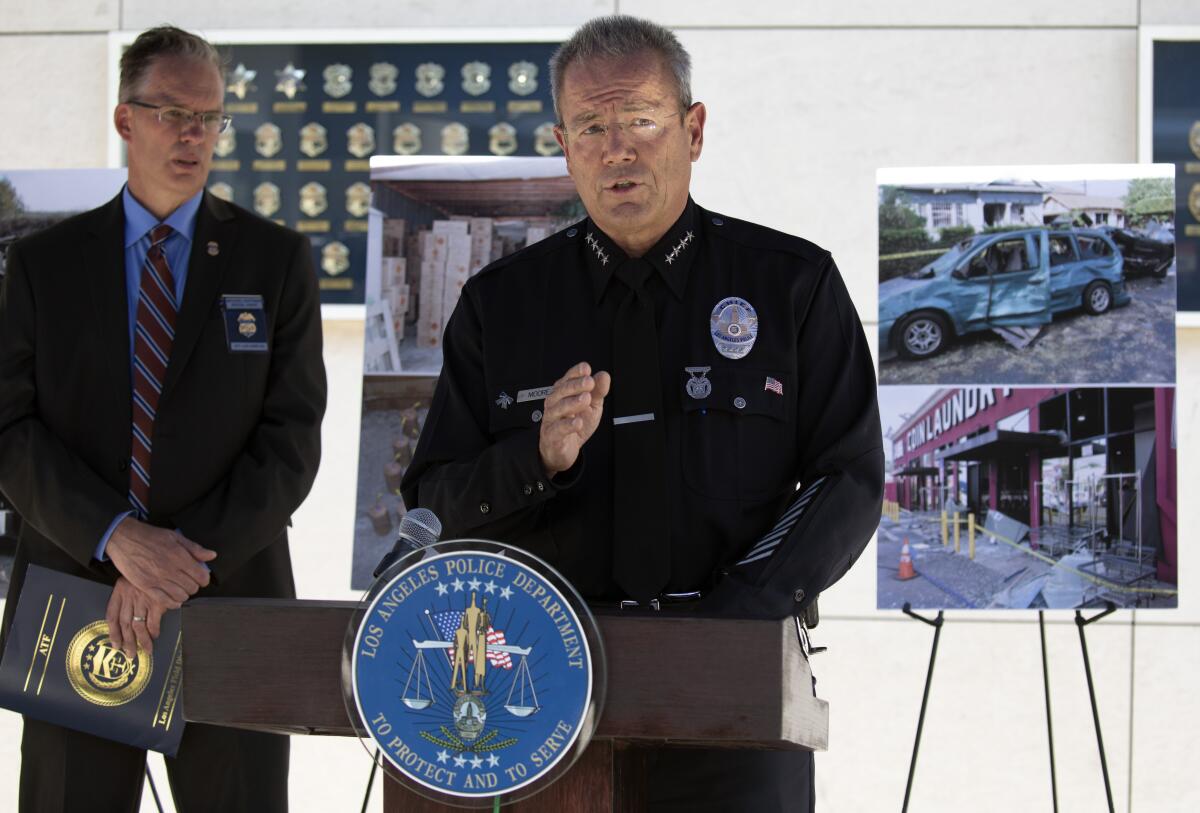
Mejia disputed Alcocer’s account. She said she and Jany identified themselves from the start and never suggested that Alcocer’s speaking to them would have any impact on whether her name would be published.
“We made it clear her name was being published no matter what,” Mejia said. She said they never mentioned having a photograph of Alcocer.
Mejia and Jany said Alcocer had a Ring door camera on her home, which may have captured what happened. The reporters urged any such video’s release.
The Times requested the video; Muniz said Alcocer declined to provide it.
Two days after the door knocking, the police union sent its email to thousands of officers, in which it claimed that it was “unacceptable” for reporters to go to an officer’s home, and wrongly implied that Jany and Mejia had been “following officers to their homes.”
Jany and Mejia did not follow Alcocer to her home. They found her address through routine research and went there during the day to see whether she wanted to talk.
Most LAPD officers are discouraged from talking to members of the media without permission and trained to direct questions to the department’s communications office when approached by reporters.
It’s unclear what media training Alcocer has, though she has given at least one media interview in the past for a feature about women in dangerous professions.
Justified journalism
Since the union’s email went out, its bogus claims have spread — including on social media.
Sal LaBarbera is a retired LAPD homicide commander turned conservative social media provocateur with a following in the wider law enforcement community. He posted Jany’s and Mejia’s images from the email in a tweet that repeated the falsehood that the reporters were “following officers to their homes.” And he suggested such a practice was “dangerous.”
Some of his social media followers responded in defense of the reporters, while others made thinly veiled threats toward them.
Tom Saggau, a spokesman for the Los Angeles Police Protective League union, said union leaders decided to “warn” LAPD officers that Times reporters were knocking on officers’ doors in part because officers are “on edge” over the recent posting of their pictures online.
“We felt that it was important that if folks we knew were knocking on doors, that we try to inform our members,” Saggau said.
He said the union has helped The Times get in touch with officers in the past, and Jany and Mejia should have reached out to union officials first before going to the bomb technicians’ homes.
Saggau said he accepts that reporters knock on doors, but union officials “don’t think it’s the wisest thing to do” when officers are already concerned about their exposure to threats.
He disputed that the email the union sent out mischaracterized the reporters’ actions, or that the union could have foreseen that it would expose the reporters themselves to threats.
Merida, The Times’ executive editor, defended the reporters.
“They are making an effort to give the subjects of their reporting an opportunity to speak for themselves and share their version of events,” Merida said. “As such, they are upholding the principles of journalism.”
Jeff Glasser, The Times’ attorney, sent a letter to Moore on Friday arguing that the LAPD had broken state law by denying previous Times requests for the officers’ names and discipline. The state requires such disclosures in instances in which officers badly injure people or there are sustained findings of unreasonable or excessive force, as was the case in the blast, Glasser said.
The Los Angeles Times Guild, the union that represents Times journalists, also defended Jany and Mejia’s actions as “standard journalistic practice for getting at the truth” and condemned “any attempt to intimidate reporters or to impede them from informing the public.”
Media experts said that, by seeking comment from Alcocer, Jany and Mejia were not crossing any ethical line, as the police claimed, but doing their constitutionally protected jobs.
The L.A. City Council voted to limit protests outside residences, passing a law that lets targets and others seek fines from unlawful demonstrators.
“Door knocking is certainly not uncommon. It is a standard journalistic practice. There’s nothing unlawful or improper or inappropriate about it,” said Katie Townsend, legal director for the Reporters Committee for Freedom of the Press. “It’s something journalists should do.”
Despite recent attempts by public officials to insulate themselves from public scrutiny, door knocking at the homes of public officials has been explicitly upheld as protected journalistic activity, experts said.
Townsend said the union’s response to Jany and Mejia’s door knocking was concerning not only because it mischaracterized standard reporting as “stalking,” but because such rhetoric coming from an institution that represents thousands of police officers could easily be perceived as an intimidation tactic.
“It seems chilling and intimidating, and that’s problematic,” she said.
Paulson said that rather than condemning reporters for trying to learn the names of officers involved in an incredibly harmful explosion that is clearly a matter of public interest, the LAPD should be reconsidering its decision to withhold those names in the first place.
“The public has every right to see extensive coverage of how police officers do their job,” Paulson said, “and to understand fully what has happened when something has gone very wrong.”
More to Read
Sign up for Essential California
The most important California stories and recommendations in your inbox every morning.
You may occasionally receive promotional content from the Los Angeles Times.
